![]()
![]()
![]()
Use LEFT and RIGHT arrow keys to navigate between flashcards;
Use UP and DOWN arrow keys to flip the card;
H to show hint;
A reads text to speech;
77 Cards in this Set
- Front
- Back
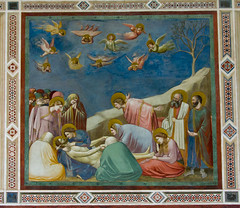
LMI
|
14-1: Arena Chapel (Pauda) fresco cycle (and frescos at Assisi and Florence Giotto Painting 1310 400
Giotto 1305-1306 Enrico Scrovegni no one can truly decide if the meaning is rebirth of the renaissance or the start of the medieval Art to scale the art to the church space Presentation of the most poignant incidents from the lives of the virgin and her parents and the life and passion of jesus and human salvation the beginning of medieval art Foreshortening |
|

LMI
|
14-2: Pisano’s panels for baptistery pulpit of Pisa Cathedral Nicola Pisano’s Sculpture 1260 402
Nicola Pissano, 1259-1260 Approx. 15 ft high. Hercules, strength and strongness. |
|
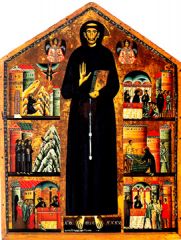
LMI
|
14-5: Saint Francis Altarpiece, Pescia, Italy Berlinghieri Painting 1235 404
Bonaventura Berlinghieri tempera on wood! San Francesco, Pescia, Italy! italo-byzantine style or maniera greca! #renaissance : rebirth of culture and literature! |
|
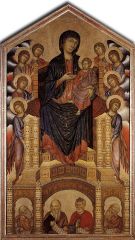
LMI
|
14-6: Madonna Enthroned with Angels and Prophets Cimabue Painting 1280 406
ca 1280-1290 Cimabue Santa Maria Novella church constructed a deeper space for the Madonna and the surrounding figures to seem as though they are surrounding Madonna and Jesus to create drapery movement and a new naturlism/movement Cimabue - one of the first artists to break from the Italo-Byzantine style tempera on wood Byzantin Style |
|

LMI
|
14-7: Madonna Enthroned, Florence Giotto Painting 1310 407constructed a deeper space for the Madonna and the surrounding figures to seem as though they are surrounding Madonna and Jesus
to create drapery movement and a new naturlism/movement Cimabue - one of the first artists to break from the Italo-Byzantine style tempera on wood Byzantin Style |
|
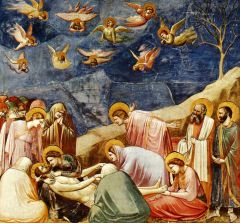
LMI
|
14-8: Lamentation, Arena Chapel Giotto Painting 1305 408constructed a deeper space for the Madonna and the surrounding figures to seem as though they are surrounding Madonna and Jesus
to create drapery movement and a new naturlism/movement Cimabue - one of the first artists to break from the Italo-Byzantine style tempera on wood Byzantin Style |
|

LMI
|
14-9: Virgin and Child Enthroned, (Maesta Altarpiece), Siena Duccio Painting 1310 411
ca.1308-1311 Duccio Di Buoninsegna sienna catedral he individualized the faces of the saints so that they would not look rigid when presorming the rituals Part of a large altarpiece much of the work is influenced by china and the middle east Tempera and gold leaf on wood 14th century Byzantine Parts of a new naturalism full of color, composition and texture and manipulation. |
|
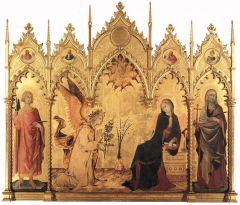
LMI
|
14-13: Annunciation, Florence Simone Martini Painting 1333 413constructed a deeper space for the Madonna and the surrounding figures to seem as though they are surrounding Madonna and Jesus
to create drapery movement and a new naturlism/movement Cimabue - one of the first artists to break from the Italo-Byzantine style tempera on wood Byzantin Style |
|

LMI
|
14-14 Birth of Virgin Pietro Lorenzetti Painting 1342 415constructed a deeper space for the Madonna and the surrounding figures to seem as though they are surrounding Madonna and Jesus
to create drapery movement and a new naturlism/movement Cimabue - one of the first artists to break from the Italo-Byzantine style tempera on wood Byzantin Style |
|
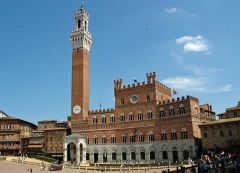
LMI
|
14-15: Palazzo Pubblico, Siena Cathedral Architecture 1330 415
1288-1309 Unknown The city of Siena it was to be the pride of the whole city to rival florence to be the center of the city and serve as a lookout to bring pride to the people who lived within the city concave facade fortified parapets |
|
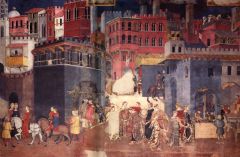
LMI
|
14-16, 14-17: Allegory of Good and Bad Government, Siena Lorenzetti Painting 1339 416/417constructed a deeper space for the Madonna and the surrounding figures to seem as though they are surrounding Madonna and Jesus
to create drapery movement and a new naturlism/movement Cimabue - one of the first artists to break from the Italo-Byzantine style tempera on wood Byzantin Style |
|
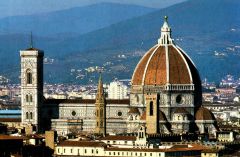
LMI
|
14-18: Florence Cathedral Arnolfo di Cambio Architecture 1334 417constructed a deeper space for the Madonna and the surrounding figures to seem as though they are surrounding Madonna and Jesus
to create drapery movement and a new naturlism/movement Cimabue - one of the first artists to break from the Italo-Byzantine style tempera on wood Byzantin Style |
|
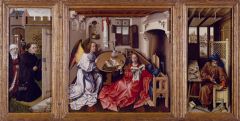
LMERNE
|
20-1: Merode Altarpiece Robert Campin Painting 1425 434
Robert Campin (Master of Flémalle), Mérode Altarpiece (open), ca. 1425-1428 Medium/materials: oil on wood Size/scale: big. Subject: A flemish home Stylistic features: Disguised symbolism for Christ, Mary’s purity, Function & significance: side panels features patrons, flower with three pedals shows the holy trinity |
|
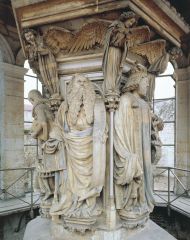
LMERNE
|
20-2: Well of Moses Claus Sluter Sculpture 1440 537
Claus Sluter, Well of Moses, Chartreuse de Champmol, Dijon, France, 1396-1406 o Materials/medium: stone o Size/scale:6ft o Subject: 6 old testament figures o Stylistic features: water symbolized blood of Christ. Moses holds copy of writings as o Function & significance: supplied water for royals an intermediary from god to the people crucifixion at very top |
|
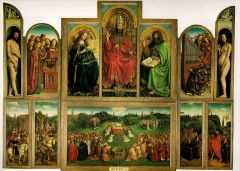
LMERNE
|
20-4, 20-5: The Ghent Altarpiece exterior/interior panels Jan van Eyck Painting 1432 541-542
• Hubert and Jan van Eyck, Ghent Altarpiece (closed), Saint Bavo Cathedral, Ghent, Belgium, completed 1432 o Materials/medium: oil on wood o Size/scale: o Subjects: god sits wearing the popes crown surrounded by Mary and John, lamb of o Stylistic features: extreme realism o Function & significance: Patron involved in the paintings god in center bottom |
|

LMERNE
|
20-6: Giovanni Arnolfini and His Bride Jan van Eyck Painting 1434 542
Jan van Eyck, Giovanni Arnolfini and His Wife, 1434 o Materials/medium: oil on wood o Size/scale:8 in x 1 ft o Subjects: couple, artist o Stylistic features: extreme symbolism, disguised o Function & significance: window; world of business broom; domestic life dog; fidelity oranges; fertility candle; all seeing eye of god bed post; St. Margret: patron saint of child birth |
|
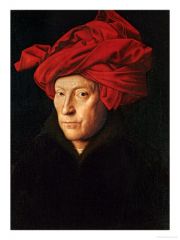
LMERNE
|
20-7: Man in a Red Turban Jan van Eyck Painting 1430 543
Jan van Eyck, Man in a Red Turban, 1433 o Materials/medium: oil on wood o Size/scale: o Subjects: eyck o Stylistic features: portrait, looks directly at the viewer, naturalistic, looking in a o Function & significance: made many self portraits mirror to get realistic look of self? |
|
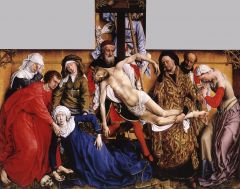
LMERNE
|
20-8: Deposition Van der Weyden Painting 1435 544
• Rogier van der Weyden, Deposition, center panel of a triptych from Notre-Dame hors-les- murs, Louvain, Belgium, ca. 1435 o Medium/materials: oil on wood o Size/scale: o Subject: Jesus taken off the cross o Stylistic features: dramatic, shallow space, strong emotional impact, mirror images o Function & significance: packed with symbolism Christ and Mary have similar poses |
|
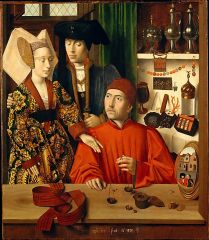
LMERNE
|
20-10: A Goldsmith in His Shop, Possibly St. Egliguis Petrus Christus Painting 1449 546
• Petrus Christus, A Goldsmith in His Shop, 1449 o Medium/materials: oil on wood o Size/scale: o Subject: goldsmith in shop, elegantly dressed couple o Stylistic features: symbolism, stones, beads, examples of finished work. Mirror gives o Function & significance: st. eiglious goldsmith before a saint perspective, couple on street expands viewers space |
|
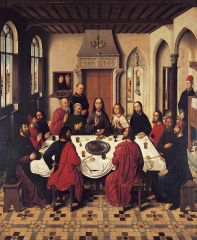
LMERNE
|
20-11: Last Supper(central panel of altarpiece) Dirk Bouts Painting 1468 547
• Dirk Bouts, Last Supper, center panel of the Altarpiece of the Holy Sacrament, Saint Peter’s, Louvain, Belgium, 1464-1468 o Materials/medium: oil on wood o Size/scale:6 ft 5 in o Subjects: Jesus in center o Stylistic features: like priest in church instead of Jesus, detached figures, Flemish attire in Flemish house, like giving a church service, biblical drama tiles lead eyes to Christ, one point perspective o Function & signifiance: patrons seen in picture frames |
|
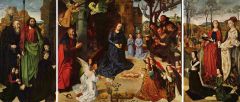
LMERNE
|
20-12: Portinari Altarpiece Van der Goes Painting 1476 547
• Hugo van der Goes, Portinari Altarpiece (open), from Sant’Egidio, Florence, Italy, ca. 1476 o Materials/medium: tempura and oil on wood o Size/scale: o Subjects: patron saint of child birth, Christ as new born on ground o Stylistic features: medicinal plants, figures are different in size and scale, disguised symbolism o Function & significance: placed in maternity hospital chapel |
|
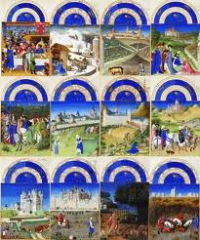
LMERNE
|
20-16: Les Tres Riches Heures du Duc de Berry Limbourg Brothers Painting 1416 551
• Limbourg Brothers (Pol, Herman, Jean), January, from Les Trés Riches Heures du Duc de Berry, 1413-1416 o Medium/materials: o Size/scale: o Subject: poor and rich o Stylistic features: symbolism international gothic style, astrological signs of where o Function & significance: shows difference of wealthy and the poor they are in the month |
|
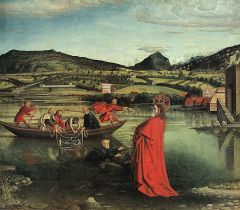
LMERNE
|
20-18: Miraculous Draught of Fish Konrad Witz Painting 1444 553
• Konrad Witz, Miraculous Draught of Fish, exterior wing of Altarpiece of Saint Peter, from the Chapel of Notre-Dame des Maccabées, Cathedral of Saint Peter, Geneva, Switzerland, 1444 o Medium/materials: oil on wood o Size/scale: o Subject: peter the first pope trying to walk on water o Stylistic features: shadows reflecting in water which give depth, movement in sky o Function & significance: biblical story set in lake Geneva one of the first depicting a specific location |
|

HRNE
|
23-1: Garden of Earthly Delights Hieronymus Bosch Painting 1505-1510 644constructed a deeper space for the Madonna and the surrounding figures to seem as though they are surrounding Madonna and Jesus
to create drapery movement and a new naturlism/movement Cimabue - one of the first artists to break from the Italo-Byzantine style tempera on wood Byzantin Style |
|
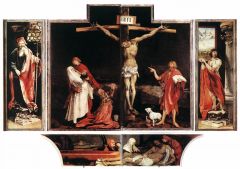
HRNE
|
23-2: Isenhein Altarpiece Matthias Grunewald Painting 1515 648constructed a deeper space for the Madonna and the surrounding figures to seem as though they are surrounding Madonna and Jesus
to create drapery movement and a new naturlism/movement Cimabue - one of the first artists to break from the Italo-Byzantine style tempera on wood Byzantin Style |
|
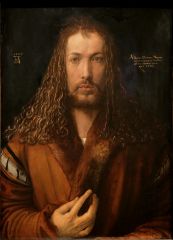
HRNE
|
S23-4: Self Portraits Albrecht Durer Painting 1500 650constructed a deeper space for the Madonna and the surrounding figures to seem as though they are surrounding Madonna and Jesus
to create drapery movement and a new naturlism/movement Cimabue - one of the first artists to break from the Italo-Byzantine style tempera on wood Byzantin Style |
|
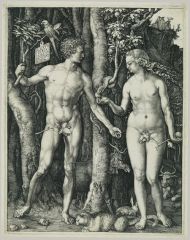
HRNE
|
23-5: Adam and Eve & Albrecht Durer Engraving 1504 650constructed a deeper space for the Madonna and the surrounding figures to seem as though they are surrounding Madonna and Jesus
to create drapery movement and a new naturlism/movement Cimabue - one of the first artists to break from the Italo-Byzantine style tempera on wood Byzantin Style |
|
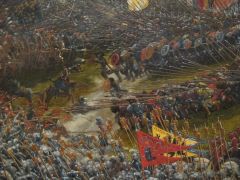
HRNE
|
23-10: The Battle of Issus Albrecht Altdorfer Painting 1529 655constructed a deeper space for the Madonna and the surrounding figures to seem as though they are surrounding Madonna and Jesus
to create drapery movement and a new naturlism/movement Cimabue - one of the first artists to break from the Italo-Byzantine style tempera on wood Byzantin Style |
|
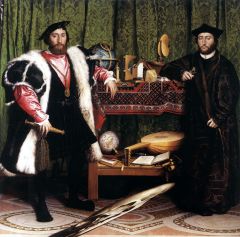
HRNE
|
23-11: The French Ambassadors Holbein the Younger Painting 1533 656constructed a deeper space for the Madonna and the surrounding figures to seem as though they are surrounding Madonna and Jesus
to create drapery movement and a new naturlism/movement Cimabue - one of the first artists to break from the Italo-Byzantine style tempera on wood Byzantin Style |
|
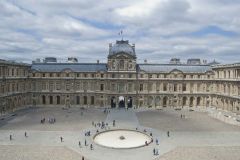
HRNE
|
23-14: Cour Carre (Square Court), Louvre, Paris Pierre Lescot Architecture 1519 657constructed a deeper space for the Madonna and the surrounding figures to seem as though they are surrounding Madonna and Jesus
to create drapery movement and a new naturlism/movement Cimabue - one of the first artists to break from the Italo-Byzantine style tempera on wood Byzantin Style |
|
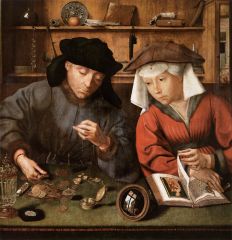
HRNE
|
23-16: Money-Changer and His Wife Quinten Massys Painting 1514 660constructed a deeper space for the Madonna and the surrounding figures to seem as though they are surrounding Madonna and Jesus
to create drapery movement and a new naturlism/movement Cimabue - one of the first artists to break from the Italo-Byzantine style tempera on wood Byzantin Style |
|
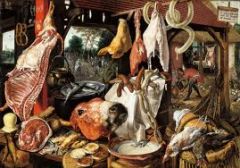
HRNE
|
23-17: Butcher’s Stall Pieter Aertsen Painting 1551 660constructed a deeper space for the Madonna and the surrounding figures to seem as though they are surrounding Madonna and Jesus
to create drapery movement and a new naturlism/movement Cimabue - one of the first artists to break from the Italo-Byzantine style tempera on wood Byzantin Style |
|
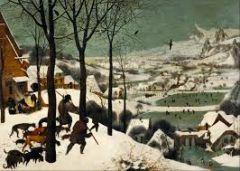
HRNE
|
23-22: Hunters in the Snow, Peasant Wedding Bruegel the Elder Painting 1565 663constructed a deeper space for the Madonna and the surrounding figures to seem as though they are surrounding Madonna and Jesus
to create drapery movement and a new naturlism/movement Cimabue - one of the first artists to break from the Italo-Byzantine style tempera on wood Byzantin Style |
|
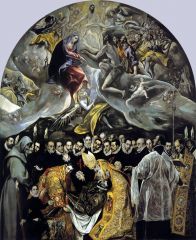
HRNE
|
23-25: Burial of Count Orgaz El Greco Painting 1586 666constructed a deeper space for the Madonna and the surrounding figures to seem as though they are surrounding Madonna and Jesus
to create drapery movement and a new naturlism/movement Cimabue - one of the first artists to break from the Italo-Byzantine style tempera on wood Byzantin Style |
|
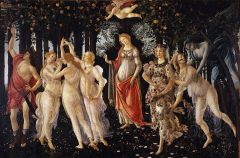
RQI
|
21‐1: Primavera Botticelli Painting 1482 558
Sandro Botticelli, Primavera, ca. 1482 Medium/materials:tempera on wood Size/scale: Subject:west wind about to carry off and marry nymph who turns into flora, venus in center, cupid on top Stylistic features: Function & significance:wedding portrait, orange fruit symbolize medici family |
|
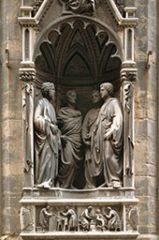
RQI
|
21‐4: The Four Saints Di Banco Sculpture 1410‐1416 563
Nanni di Banco, Four Crowned Saints, Or San Michele, Florence, Italy, ca. 1410-1416 Materials/medium: Size/scale: Subject:4 christian sculptures, sculptures working on craft at bottom Stylistic features:within architecture, realistic faces, discussing their fate Function & significance: |
|
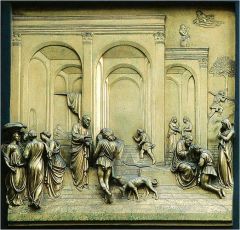
RQI
|
21‐9 to 21‐11: Gates of Paradise, Isaac and His Sons Ghiberti Sculpture 1425‐1452 566
Lorenzo Ghiberti, east doors (Gates of Paradise), Baptistery of San Giovanni, Florence, Italy, 1425-1452 Materials/medium:bronze Size/scale: 5’2’’ life size Subject:david and goliath's head Stylistic features:1st freestanding nude since antiquity, contrapposto, nonchalant expression, hat and boots with sword and shield Function & significance:in medici garden, symbol as florence |
|
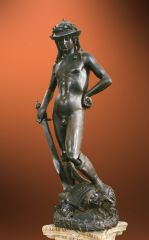
RQI
|
21‐12: David Donatello Sculpture 1440‐1460 568
Donatello, David, ca. 1440-1460 Materials/medium:bronze Size/scale: 5’2’’ life size Subject:david and goliath's head Stylistic features:1st freestanding nude since antiquity, contrapposto, nonchalant expression, hat and boots with sword and shield Function & significance:in medici garden, symbol as florence |
|

RQI
|
21‐13: David Verrocchio Sculpture 1465‐1470 569
Andrea del Verrocchio, David, ca. 1465-1470 Materials/medium:bronze Size/scale:4’1’’ Subject:david and goliath’s head Stylistic features:more masculine, leather outfit, contrapposto, brash young man, warrior, covered up, not nude Function & significance: |
|
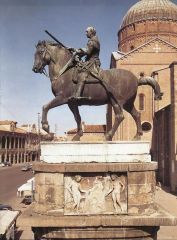
RQI
|
21‐16: Gattamelata Donatello Sculpture 1445‐1453 571
Donatello, Gattamelata (equestrian statue of Erasmo da Narni), Piazza del Santo, Padua, Italy, ca. 1445-1453 Materials/medium:bronze Size/scale: 12 feet high Subject:deceased man was not head of state Stylistic features:compare to marcus a, Function & significance: holds world in hand symbolizing domination |
|
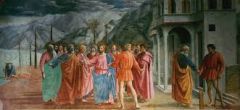
RQI
|
21‐19: Tribute Money Masaccio Painting 1424‐1427 574
Masaccio, Tribute Money, Brancacci chapel, Santa Maria del Carmine, Florence, Italy, ca. 1424-1427 Medium/materials:fresco Size/scale: 8x19 Subject:story of the tax collector Stylistic features:atmospheric perspective, realistic architectural structure, shadows, realistic texture to clothing, continuous narrative, figures cast realistic shadows, aerial perspective, one point perspective Function & significance: |
|

RQI
|
21‐21: Holy Trinity Masaccio Painting 1424‐1427 575
Masaccio, Holy Trinity, Santa Maria Novella, Florence, Italy, ca. 1424-1427 Medium/materials:Fresco Size/scale: Subject: Stylistic features: Architectural features, men sitting outside architecture, donors are in picture, triumphant arch with realistic deep perspective, one point perspective Function & significance:reminder of death |
|
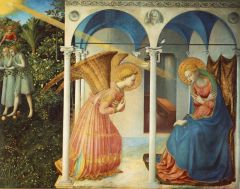
RQI
|
21‐22: Annunciation Fra Angelico Painting 1438‐1447 576
Fra Angelico, Annunciation, Can Marco, Florence, Italy, ca. 1438-1447 Medium/materials:fresco Size/scale:7’ 10’’ Subject: delicate figures Stylistic features: architecture reflects that of a monastery, sitting realistically but bodys are bigger than architecture, deep perspective Function & significance: |
|
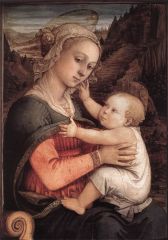
RQI
|
21‐24: Madonna and Child Filippo Lippi Painting 1460‐1465 577
Fra Filippo Lippi, Madonna and Child with Angels, ca. 1460-1465 Medium/materials: Size/scale: Subject: Stylistic features: more realistic beautiful portrayal of people Function & significance: |
|

RQI
|
21‐25: Resurrection Della Francesca Painting 1463‐1465 578
Piero della Francesca, Resurrection, Palazzo Communale, Borgo San Sepolcro, Italy, ca. 1463-1465 Medium/materials:fresco Size/scale:7x6 Subject:christ steps out of sarcophagus Stylistic features:christs foot on lid of sarcophagus, guards sleeping Function & significance: |
|
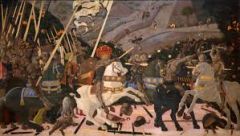
RQI
|
21‐28: Battle of San Romano Uccello Painting 1455 580
Paolo Uccello, Battle of San Romano, ca. 1435 or ca. 1455 Medium/materials: tempera on wood Size/scale: Subject:battle of florence and siena Stylistic features:trained in international style, white horse leads charge, horses look like toys, cartoonish Function & significance:in lorenzos bedroom, orange fruit symbolizes medici family |
|
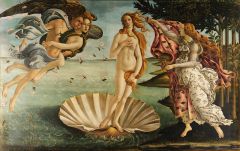
RQI
|
21‐29: Birth of Venus Botticelli Painting 1484‐1486 581
Sandro Botticelli, Birth of Venus, ca. 1484-1486 Medium/materials:tempera on canvas Size/scale: Subject:venus Stylistic features: modeled after hellenistic aphrodite, from mythology, action in linear style, influenced from international style Function & significance:created on style |
|
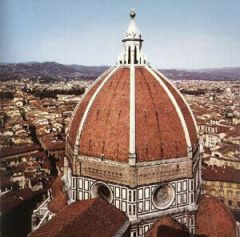
RQI
|
21‐30A: Dome of Florence Cathedral, Brunelleschi Architecture 1420‐1436 582
Filippo Brunelleschi, Florence Cathedral Dome, 1420-1436 Description:raised to increase height that we hadn't experienced before, can walk around dome Construction technique: |
|
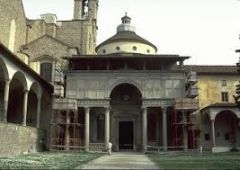
RQI
|
21‐34‐21‐36: : Pazzi Chapel Brunelleschi Architecture begun 1433 584
Filippo Brunelleschi, facade of the Pazzi Chapel, Santa Croce, Florence, Italy, begun 1433 Description & architectural features: 1st renaissance central plan, finished after his death, Filippo Brunelleschi, plan of the Pazzi Chapel, Santa Croce, Florence, Italy, begun 1433 Description & architectural features:central plan Filippo Brunelleschi, interior of the Pazzi Chapel, Santa Croce, Florence, Italy, begun 1433 Description & architectural features: detailing, terracotta white medallions put throughout interior |
|
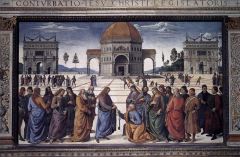
RQI
|
21‐41: Christ Delivering the Keys of the Kingdom to St. Peter Perugino Painting 1481‐1483 589
Perugino, Christ Delivering the Keys of the Kingdom to Saint Peter, Sistine Chapel, Vatican, Rome, Italy, 1481-1483 Medium/materials:fresco Size/scale:aa’5”x18’8” Subject:right background is stoning of christ Stylistic features:one point perspective, shows arch of constantine, all figures stand in contrapposto, Function & significance: |
|
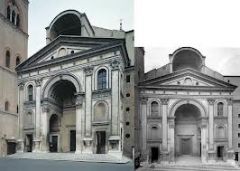
RQI
|
21‐45 to 21‐47: Sant’Andrea, in Mantua Alberti Architecture begun 1472 593
Leon Battista Alberti, west façade of Sant’Andrea, Mantua, Italy, designed 1470, begun 1472 Description & architectural features: redesigned and replaced earlier church, triumphant arch, three stories high Leon Battista Alberti, plan of Sant’Andrea, Mantua, Italy, designed 1470, begun 1472 Description & architectural features: Leon Battista Alberti, interior of Sant’Andrea, Mantua, Italy, designed 1470, begun 1472 Description & architectural features:thick walls alternate with vaulted chapels, massive dome crossing built at a later date, took nine years to complete all the frescoes, ceiling looks like paintings are looking down at us, painted in a bedroom, cubic shape but looks like a dome, dramatically foreshortened angels, |
|
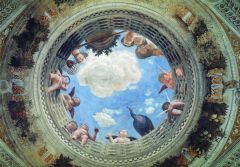
RQI
|
21‐48 to 21‐49: Ceiling of the Camera Picta Mantegna Painting 1465‐1474 594‐595
Andrea Mantegna, ceiling of the Camera Picta (Painted Chamber), Palazzo Ducale, Mantua, Italy, 1465-1474 Medium/materials: Subjects: Stylistic features: Function & significance: |
|
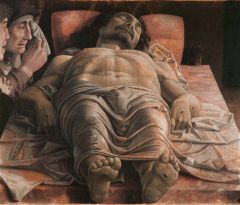
RQI
|
21‐50: Lamentation over the Dead Christ Mantegna Painting c. 1500 596
Andrea Mantegna, Foreshortened Christ (Lamentation over the Dead Christ), ca. 1500 Medium/materials: tempera on canvas Size/scale: Subject:christ on death bed Stylistic features: extremely foreshortened Function & significance: |
|
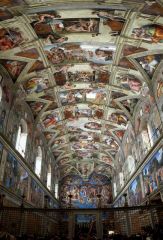
RMCI
|
22‐1: Sistine Chapel Ceiling Michelangelo Painting 1512 598constructed a deeper space for the Madonna and the surrounding figures to seem as though they are surrounding Madonna and Jesus
to create drapery movement and a new naturlism/movement Cimabue - one of the first artists to break from the Italo-Byzantine style tempera on wood Byzantin Style |
|
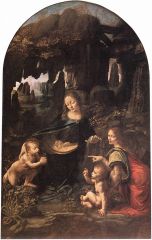
RMCI
|
22‐2: Madonna of the Rocks Leonardo da Vinci Painting 1483 601
Leonardo da Vinci, Madonna of the Rocks, from San Francesco Grande, Milan, Italy, begun 1483 Materials/medium:oil on wood Size/scale: Subject:madonna on the rocks Stylistic features: expressing emotional state, atmospheric perspective, pyramidal grouping johns view ads in the viewer, chiaroscuro Function & significance: |
|
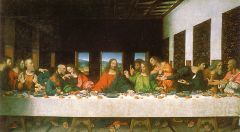
RMCI
|
22‐4: Last Supper Leonardo da Vinci Painting 1495‐1498 602
Leonardo da Vinci, Last Supper, ca. 1495-1498 Materials/medium & location: oil and tempera on plaster, dining hall in milan Size/scale: Subject:the last supper Stylistic features: painted on top of dry plaster, but didn't last. great drama of the moment, put judas within other disciples, groups people, one point perspective point to jesus, all reacting to each other, judas in darkness (indirect) Function & significance: restored so much that there probably isn't much left of what leonardo actually did 80% restored |
|
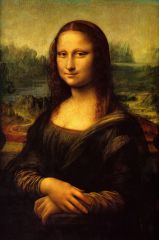
RMCI
|
22‐5: Mona Lisa Leonardo da Vinci Painting 1503‐1505 603
Leonardo da Vinci, Mona Lisa, ca. 1503-1505 Materials/medium: oil on wood Size/scale: Subject: wife of wealthy florentine Stylistic features:doesn't wear any jewelry, looks directly in the eyes of viewers which went againsts ethics, sfumato, chiaroscuro, atmospheric perspective, pyramidal composition Function & significance: different from other portraits, doesn't show wealth, looks directly at viewer |
|

RMCI
|
22‐7: Marriage of the Virgin Raphael Painting 1504 605
Raphael, Marriage of the Virgin, from the Chapel of Saint Joseph, San Francesco, Cittá di Castello, Italy, 1504 Materials/medium oil on wood: Size/scale: Subject:priest gives virgin to suiter, joseph holds wedding ring Stylistic features: foreshortening (suiter breaks rod) Function & significance: see influence of teachers, learned craft from father |
|

RMCI
|
22‐9: School of Athens Raphael Painting 1509‐1511 607
Raphael, Philosophy (School of Athens), Stanza della Segnatura, Vatican Palace, Rome, Italy, 1509-1511 Materials/medium:fresco Size/scale: Subject:shows famous religious people and scientists together Stylistic features:split in the middle, shows both religion and science in one painting, statues of athena and apollo in back, plato, aristotle,heraclitusin foreground, micheaelangelo writing a poem, raphael, buildings reflect saint peters Function & significance: commissioned for an office (Julius II) |
|
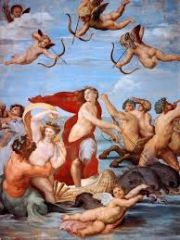
RMCI
|
22‐11: Galatea Raphael Painting 1513 608
Raphael, Galatea, Sala di Galatea, Villa Farnesina, Rome, Italy, ca. 1513 Materials/medium:fresco Size/scale: Subject:based on poetry Stylistic features:composition rests on series of triangles , lively bodies energetically arranged Function & significance: based on poetry inspired by birth of venice |
|
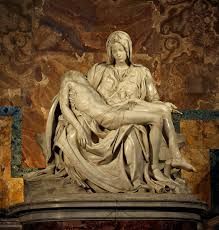
RMCI
|
22‐12: Pieta Michelangelo Sculpture 1498‐1500 610
Michelangelo Buonarroti, Pietá, ca. 1498-1500 Materials/medium:marble Size/scale: Subject:mary holding dead jesus Stylistic features:not actually in proportion, mary has ageless beauty full of purity. jesus limp, mary holding his dead weight, little negative space, frontal viewpoint, pyramidal, heavy drapery Function & significance:one of the only times he signed his work |
|
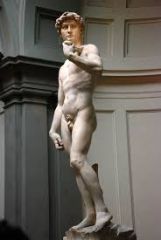
RMCI
|
22‐13: David Michelangelo Sculpture 1501‐1504 611
Michelangelo Buonarroti, David, from Piazza della Signoria, Florence, Italy, 1501-1504 Materials/medium:marble Size/scale:17 ft high Subject:david and goliath Stylistic features:before the battle begins, tension, energy, before victory, contrapposto, little negative space, muscles,large hands and feet, swellig vains, monumental form, Function & significance:meant to be put in middle of city david symbol for florence, compare to classical hellenistic statues |
|
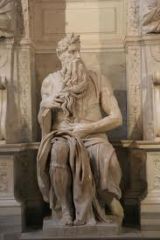
RMCI
|
22‐14:Moses Michelangelo Sculpture 1513‐1515 612
Michelangelo Buonarroti, Moses, from the tomb of Pope Julius II, Rome, Italy, ca. 1513-1515 Materials/medium:marble Size/scale:7 ft tall Subject:moses Stylistic features:originally meant to be seen from below, angry because people are worshiping false idols, horns, heroic body,idealized form Function & significance: self thought to be his best work originally put in a tomb |
|

RMCI
|
22‐17 to 22‐18: ceiling of Sistine Chapel, Creating of Adam Michelangelo Painting: 1508‐1512 614‐615
Michelangelo Buonarroti, ceiling of the Sistine Chapel, Vatican City, Rome, Italy, 1508-1512 Materials/medium:fresco Size/scale: General description:curved ceiling caused a lot of problems, had to redo section because it didn't look right, created in less than four years, main doctrine, more than 300 figures and n o one has the same pose, creation around crown, old testament in four corners, male nude in motion, variety of expression, |
|
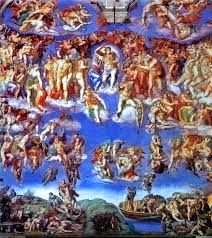
RMCI
|
22‐19: Sistine Chapel – Last Judgment fresco Michelangelo Painting: 1536‐1541 616
Michelangelo Buonarroti, Last Judgment, altar wall of the Sistine Chapel, 1536-1541 Description & stylistic features:Subject:christ as judge Stylistic features: dead are rising (bottom) ascending up and down (middle) those rising to heaven ( top) Function & significance:criticized because he used creatures from dantes inferno so they painted over some of his figures. |
|
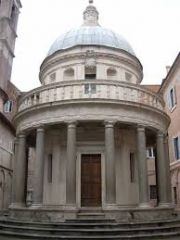
RMCI
|
22‐21: Templetto Bramante Architecture: begun 1502 618
Donato d’Angelo Bramante, Tempietto, San Pietro in Montorio, Rome, Italy, begun 1502 Description & architectural features: made in a circle to represent divine perfection, proportions are repeated on other levels Function & significance: believed saint peter was crucified here, looks like temple of vesta |
|
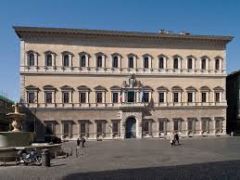
RMCI
|
22‐26 to 22‐27: Palazzo Farnese Sangallo the Younger Architecture: 1530 621
Antonio da Sangallo the Younger, Palazzo Farnese, Rome, Italy, 1517-1546; completed by Michelangelo Buonarroti, 1546-1550 Description & architectural features: Significance: |
|
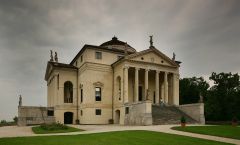
RMCI
|
22‐28: Villa Rotonda Palladio Architecture: 1550‐1570 622
Andrea Palladio, Villa Rotonda (formerly Villa Capra), near Vicenza, Italy, ca. 1550-1570 Description & architectural features:named from greek goddess of wisdom, built for wealthy farmers,located on a hill top, central plan with four identical walls, each porch had different views of the landscape, influenced colonial house, Significance: |
|

RMCI
|
22‐34: Tempest Giorgione Painting 1510 626
Giorgione da Castelfranco, The Tempest, ca. 1510 Materials/medium:oil on canvas Size/scale: Subject:n/a Stylistic features:painted man over nude woman, softer tonalities, harmony, poetry theme Function & significance: inspired by classical renaissance poetry |
|

RMCI
|
22‐37: Madonna of the Pesaro Family Titan Painting 1519‐1526 628
Titian, Madonna of the Pesaro Family, 1519-1526 Materials/medium:oil on canvas Size/scale: Subject: Stylistic features:strong diagonals and triangles, madonna placed off center but still center of focus, balanced by color rather than a specific design Function & significance:venetian victory against the turks |
|
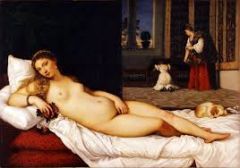
RMCI
|
22‐39: Venus of Urbino Titan Painting 1538 629
Titian, Venus of Urbino, 1536-1538 Materials/medium:oil on canvas Size/scale: Subject:sensual venus Stylistic features:rounded body contrast by clear vertical curtain,, dog symbolizes fidelity,landscape through window in the back Function & significance:served to influence many future art pieces |
|
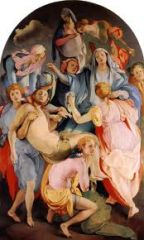
RMCI
|
22‐42: Entombment of Christ Pontormo Painting 1525‐1528 632
Jacopo da Pontormo, Entombment of Christ, Capponi chapel, Santa Felicitá, Florence, Italy, 1525-1528 Materials/medium:oil on wood Size/scale: Subject: Stylistic features: elongated bodies, circular compostion, high colors, what ios mary sitting on? no weeping, no emotion, anti classical form Function & significance: |
|
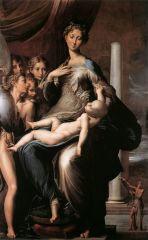
RMCI
|
22‐44: Madonna with the Long Neck Parmigianino Painting 1534‐1540 633
Parmigianino, Madonna with the Long Neck, from the Baiardi chapel, Santa Maria dei Servi, Parma, Italy, 1534-1540 Materials/medium: Size/scale: Subject: Stylistic features:small head long neck, crowded heads on left, out of proportion, Function & significance: |
|
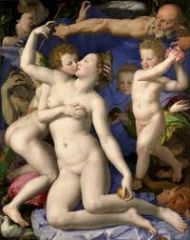
RMCI
|
22‐45: Venus, Cupid, Folly, and Time Bronzino Painting 1546 634
Bronzino, Venus, Cupid, Folly, and Time, ca. 1546 Materials/medium: oil on pqanel Size/scale: Subjectvenus and cupid: Stylistic features:dove symbolizes love, fraud and vanity has beautiful face, complex imagery and poses, conjested compostion, pushed forward, coming right at us |
|
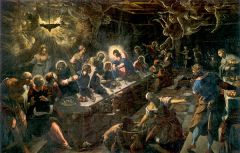
RMCI
|
22‐48: Last Supper Tintoretto Painting 1594 636
Tintoretto, Last Supper, 1594 Materials/medium:oil on canvas Size/scale: Subject: Stylistic features:christ is in the center, powerful diagnols lead eye to back ground, light cast long shadows, elongated figures, no action, nameless people Function & significance: |
|
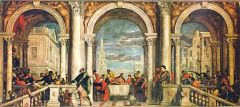
RMCI
|
22‐49: Feast in the House of Levi Veronese Painting 1573 636
Paolo Veronese, Christ in the House of Levi, from the refectory of Santi Giovanni e Paolo, Venice, Italy, 1573 Materials/medium:oil on canvas Size/scale: Subject: Stylistic features:large vast architectural setting, setting overwhelms the painting Function & significance: |
|
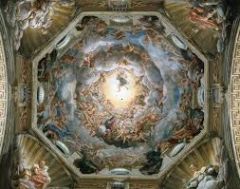
RMCI
|
22‐51: Assumption of the Virgin fresco Correggio Painting 1526‐1530 638
Correggio, Assumption of the Virgin, 1526-1530 Materials/medium: Size/scale: Subject: Stylistic features:ceiling painting which is illusionistic Function & significance: |

